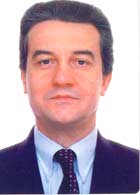Contents: 2024 | 2023 | 2022 | 2021 | 2020 | 2019 | 2018 | 2017 | 2016 | 2015 | 2014 | 2013 | 2012 | 2011 | 2010 | 2009 | 2008 | 2007 | 2006 | 2005 | 2004 | 2003 | 2002 | 2001
2005, 15
A survey of the acoustic quality for speech in auditoriums
language: English
received 02.04.2005, published 27.05.2005
Download article (PDF, 600 kb, ZIP), use browser command "Save Target As..."
To read this document you need Adobe Acrobat © Reader software, which is simple to use and available at no cost. Use version 4.0 or higher. You can download software from Adobe site (http://www.adobe.com/).
ABSTRACT
A sample of auditoriums in the city of São Paulo was surveyed in terms of the acoustic quality for speech. The sample was selected based on interviews with well-known actors and actresses of the Brazilian drama community, and with other professionals of the scenic arts as well. Sound decays, the strength and objective measures of speech intelligibility were measured throughout the auditoriums, which were then ranked based on position-averaged values. The variations in the values of the measured parameters with the measuring position are discussed and correlations between them are established. An attempt was made to validate the Objective Support (ST1-Gade) as an objective measure of support to actors on stage. The preliminary diagnosing results with ray tracing simulations are presented. A guideline of less than 5 cubic meters per seat, to achieve reverberation times of less than 1 s in auditoriums for drama has emerged from the results of the measurements.
16 pages, 5 figures
Сitation: Sylvio R. Bistafa, Milton V. Granado. A survey of the acoustic quality for speech in auditoriums. Electronic Journal “Technical Acoustics”, http://www.ejta.org, 2005, 15.
REFERENCES
1. R. S. Shankland. Architectural acoustics in America to 1930. J. Acoust. Soc. Am., 1977, 61(2), 250–254.
2. H. Haas. Uber den einfluss des einfachechos auf die horsamkeit von sprache. Acustica, 1951, 1, 49–58.
3. R. D. Fay, W. M. Hall. Historical notes on the Hass effect. J. Acoust. Soc. Am., 1956, 28, 131–132.
4. F. Aigner, M. J. O. Strutt. On the physiological effect of several sources of sound on the ear and its consequences in architectural acoustics. J. Acoust. Soc. Am., 1935, 6, 155–159.
5. J. P. A. Lochner, J. F. Burger. The influence of reflections on auditorium acoustics. J. Sound Vibr., 1964, 1(4), 426–454.
6. R. Thiele. Richtungsverteilungs und zeitfolge der schallruckewurfe in raumen. Acustica, 1953, 3, 291–302.
7. J. S. Bradley. Relationships among measures of speech intelligibility in rooms. J. Audio Eng. Soc., 1998, 46, 396–405.
8. H. G. Latham. The signal-to-noise ratio for speech intelligibility – An auditorium acoustics design index. App. Acoust., 1979, 12, 253–320.
9. IEC Std. 60268-16. Objective rating of speech intelligibility by the Speech Transmission Index. 2nd ed., International Electrotechnical Commission, Geneva, Switzerland (1998–03).
10. S. R. Bistafa, J. S. Bradley. Revisiting algorithms for predicting the articulation loss of consonants Alcons. J. Audio Eng. Soc., 2000, 48, 531–544.
11. S. R. Bistafa, J. S. Bradley. Reverberation time and maximum background-noise level for classrooms from a comparative study of speech intelligibility metrics. J. Acoust. Soc. Am., 2000, 107(2), 861–875.
12. Barron M. Auditorium Acoustics and Architectural Design. London, E & FN SPON, 1993.
13. J. S. Bradley, S. R. Bistafa. Relating speech intelligibility to useful-to-detrimental sound ratios (L). J. Acoust. Soc. of Am., 2002, 112(1), 27–29.
14. T. Houtgast, H. J. M. Steeneken. A multi-language evaluation of the RaSTI-Method for estimating speech intelligibility in auditoria. Acustica, 1984, 54, 185–199.
15. A. C. Gade. Investigations of Musicians’ Conditions in Concert Halls. II: Field Experiments and Synthesis of Results. Acustica, 1989, 69, 249–262.
 |
Sylvio R. Bistafa is a professor in the Mechanical Engineering Department of the Polytechnic School and in the Technological Department of the School of Architecture and Urban Planning at the University of São Paulo, Brazil. He obtained his undergraduate degree in Mechanical Engineering at the Industrial Engineering College in São Bernardo do Campo, Brazil. His M.Sc. and Ph.D. degrees were obtained at The Pennsylvania State University, USA, working on fluid flow caused noise. He teaches fluid mechanics and applied acoustics, and has done work on architectural acoustics, environmental acoustics, transportation noise and noise control engineering. He holds four patents in co-authorship, and has written or co-authored more than 80 publications in technical journals or conference proceedings. From 1998 to 2000 he was visiting scientist with the Acoustic Group at the National Research Council Canada working on speech intelligibility and speech quality in classrooms and meeting rooms. In 2000 he has done research on sound waves in complex systems as a visiting scholar in the Department of Theoretical and Applied Mechanics at the University of Illinois in Urbana-Champaign. He is a former president of the Brazilian Acoustical Society, a Fellow Member of The Institute of Noise Control Engineering of the USA, and a Member of The Acoustical Society of America. e-mail: sbistafa(at)usp.br |
|
 |
Milton V. Granado, Jr. is a part-time professor in the School of Architecture and Urban Planning at the Mackenzie Presbyterian University in São Paulo where he teaches architectural acoustics. He obtained his undergraduate, master and doctoral degrees in the School of Architecture and Urban Planning at the University of São Paulo, Brazil. He is a professional architect working in the areas of thermal, lightening and acoustic comfort in buildings. He is a member of the Brazilian Acoustical Society. |
|
